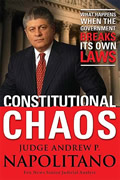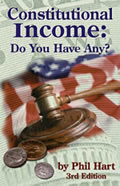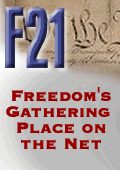Other
Vieira
Articles:
Are Monetary & Banking Crises Inevitable in the Near Future?
"Homeland Security" -- For What and For Whom?
"THE
MILITIA OF THE SEVERAL STATES"
GUARANTEE THE RIGHT TO KEEP AND BEAR ARMS
PART 6 of 8
Dr.
Edwin Vieira, Jr., Ph.D., J.D.
April 3, 2006
NewsWithViews.com
Continuing the analysis of the Militia in the Constitution begun in the previous parts of this commentary, we turn to...
6. The principles of "the Militia of the several States" compared with today's "gun control." The contrasts between the proliferation and dispersion of firearms and ammunition among the vast mass of the people in pre-constitutional times, and the contemporary political campaign to restrict to the point of total prohibition the private possession of firearms by common Americans, are stark, striking, and to any constitutionalist sickening. For example--
THEN: The armed people constituted, and understood themselves to be, an important component of the government; their possession of firearms was a governmental as well as a personal duty and right; and their arms were the very symbols and instruments of their legal authority.
NOW: The severe limitations on, or even prohibition of, private possession of firearms proposed by "gun controllers" separate "the government" (and its armed minions) from everyone else, creating a dangerous dichotomy between "the rulers" and "the ruled" that must inevitably widen into an antagonistic rift between "us" and "them."
THEN: Possession (and usually ownership) of firearms was near-universal and compulsory among free men. Almost every able-bodied free man was required to be armed. Only a few exemptions excused men from mustering and training, and only the claim of conscientious objection excused any free man from possessing firearms.
NOW: The goal of "gun controllers" is to render possession of firearms minimal and highly selective--confined to the armed forces, the police, and the specially privileged among the political elite. Only a vanishingly few, if any, exemptions will allow common Americans to possess firearms for any reason.
THEN: The government supplied firearms to the poor, or assisted them in procuring firearms for themselves in the free market.
NOW: "Gun controllers" demand that the government disarm as many people as possible, and seek to make commerce in firearms prohibitively expensive and cumbersome for common Americans, thereby disproportionately burdening the poor. (The rich and powerful will always have ready access to firearms, if not in their own hands then in the hands of private security personnel.)
THEN: Disarmament by force of law was limited to actual or potential enemies--hostile Indians, unruly slaves, or disloyal citizens--or to conscientious objectors, who disarmed themselves for their own reasons of conscience. Individuals exempted by age, disability, office, profession, or trade from active service in the Militia were never disarmed. The purpose of laws pertaining to firearms was to promote the widespread possession of firearms.
NOW: The ultimate goal of "gun controllers" is to disarm everyone under color of law, except the armed forces, the police, and the politically privileged. The purpose of "gun laws" is to limit or prohibit common Americans' possession of firearms to the maximum degree politically possible.
THEN: Licensing and registration of firearms were superfluous. Because the Militia Acts required almost every able-bodied free man to be armed, everyone knew that most everyone else possessed one or more firearms. Nevertheless, regular inspections were conducted in order to insure that everyone actually possessed the firearms and ammunition the laws required. But no Militia Act ever required licensing, registration, or even inspection of firearms other than Militia firearms.
NOW: "Gun controllers" propose registration of every kind of firearm (including even air rifles) as the step preliminary or corollary to licensing, which is the step preliminary to prohibition. Searches and seizures will be conducted to ferret out people who are not licensed, and to discover firearms slated for confiscation and destruction.
THEN: Almost every able-bodied free man was required to possess firearms and ammunition of the same type and effectiveness as the regular army fielded. Moreover, because everyone was armed, and knew how to use his firearms, the Militia vastly "outgunned" the army, and even more so the sheriffs, constables, and all other public officials who performed duties of a police nature.
NOW: "Gun controllers" seek to deny common Americans firearms of most modern military types, as well as all other firearms that could be employed effectively to oppose armed forces or police in the service of usurpers and tyrants. On the plea that the people must not be permitted to "outgun" the police (let alone the armed forces), "gun controllers" demand prohibition of private possession of semiautomatic "assault rifles" (full automatics being already regulated to near extinction), semiautomatic rifles of any configuration, .50 BMG caliber rifles, "sniper rifles" (that is, accurate rifles with optical sights)--and some day soon even the lever-action carbines that John Wayne made famous in his Westerns, when they discover how effective those guns can be in the hands of well-trained men.
THEN: No Militia Act or other law prohibited private ownership or possession of firearms other than Militia firearms. Even muskets or rifles possessed, and useful, solely for hunting or sport were within every free man's right.
NOW: "Gun controllers" contend that "the right to keep and bear Arms" includes only firearms with a provable "sporting" or "recreational" purpose, but not firearms of military types. They also assert that, "right" or no "right," even "sporting" firearms ought to be licensed, registered, prohibited, and confiscated (doubtlessly because they realize that any "sporting" firearm can be used for a military purpose in the hands of a guerrilla, partisan, or resistance fighter).
THEN: No Colony or independent State employed exorbitant taxes to impose financial disincentives on the private possession of firearms. To the contrary: many Militia Acts exempted firearms from seizure and sale for the payment of private debts or taxes.
NOW: The first major Congressional "gun law" (still on the books after some 70 years) uses taxes to burden and inhibit private commerce in fully automatic and other types of firearms.
THEN: No Militia Act prohibited any free man from purchasing or possessing "too many" firearms, or "too much" ammunition. To the contrary: almost every free man was required to have at least one firearm and some minimum quantity of ammunition in his possession at all times.
NOW: "Gun controllers" promote statutes restricting private purchases to "one gun a month" (or some other such formula), as well as so-called "private-arsenal laws" that limit, or impose punitive taxes based on, the number of firearms or amounts of ammunition an individual possesses.
THEN: No Militia Act ever required that firearms and ammunition be kept away from all Militiamen in governmental arsenals until distributed by public officials for musters or training, and later collected again for storage.
NOW: "Gun controllers" seek to prohibit the private possession of firearms, except when handed out from government arsenals to licensed individuals for "sporting" purposes, then to be taken back and secured under lock and key.
THEN: Almost every able-bodied free man from 16 to 50 or 60 mustered and trained with firearms on a regular basis.
NOW: "Gun-free schools" instill a fear and hatred of firearms in children from the earliest age. Rather than being educated as to the social and political necessity for citizens to keep and bear arms, and trained to use firearms safely and effectively, children are being conditioned to react to all firearms in private hands as a threat.
THEN: No Militia Act specified that Militia firearms were not to be borne at times and places other than musters and training, or that firearms other than Militia firearms were not to be borne in any particular places or at any particular times.
NOW: Public and private "gun-free zones" are metastasizing across America like melanoma.
THEN: No Militia Act prohibited or penalized self-defense with Militia firearms, or with firearms other than Militia firearms.
NOW: A homicide committed with a firearm in self-defense often results in an indictment for murder, massive fees and costs for legal defense, notoriety in the media, and psychic trauma, even if the charges are proven specious and the defendant is acquitted. The "gun controllers'" goal is to outlaw armed self-defense entirely (as has been tried in England), as another reason for a complete confiscation of privately owned firearms--because who needs the means if the end is prohibited?
THEN: The near-universal private possession of firearms was recognized as the precondition for freedom--as the Second Amendment says, "[a] well regulated Militia, being necessary to the security of a free State."
NOW: The near-universal private prohibition of firearms must inevitably result in exposing most Americans to the "due Subjection and Obedience" of slavery. Is it possible that the proponents of such a prohibition do not understand this? And if they understand it, that they do not desire it?
Given that the principles of the pre-constitutional Colonial and State Militia, as found in every Militia Act from the mid-1600s to the late 1700s, define "the Militia of the several States" and their legal characteristics for all constitutional purposes--and given that, with respect to "the right of the people to keep and bear Arms," the Constitution has not been amended since the Second Amendment was ratified to guarantee that that right "shall not be infringed"--and given the plain contradictions between the principles of "the Militia of the several States" and the goals of contemporary "gun controllers" just illustrated--and given that the success of "gun control" will hasten the end of a free America--how then can contemporary "gun control" be rationally defensible, let alone the subject of legislation that the judiciary all too often sustains?! How, indeed, is the promotion of contemporary "gun control" not a criminal activity, and the people who promote it not participants in a criminal enterprise?
7. The relation of the Second Amendment to the Militia Clauses of the Constitution. Whether or not Alexander Hamilton and his co-thinkers were correct to dismiss the Bill of Rights as unnecessary and superfluous, the foregoing PARTS of this commentary prove that the Second Amendment must be interpreted in light of and consistent with--even simply as a restatement, amplification, or emphasis of--the original Militia Clauses of the Constitution.
The skeptic may object that, whereas the Second Amendment speaks of "the right of the people to keep and bear Arms," the Militia Clauses do not speak of any such right at all. So that, if "the right of the people to keep and bear Arms" has any explicit constitutional protection, the Amendment must be its locus. That contention forgets, though, that if the Constitution delegates no power to the General Government to interfere with "the right of the people to keep and bear Arms," or delegates a power solely to promote that "right" under some other terminology, then no explicit guarantee is necessary, in the Bill of Rights or anywhere else.
True enough, the Second Amendment does refer specifically to "the right of the people to keep and bear Arms." But what "right" does it mean? The Amendment itself does not create that "right" out of whole cloth, specifying its particulars. So what is the source of "the right of the people to keep and bear Arms"? What is its content? And who may exercise it? The Amendment contains neither derivation, nor definition, nor explanation. To comprehend the nature and scope of the Amendment therefore requires recourse to more than simply its words. That, however, poses no insuperable problem. "That the Constitution contains no express provision on the subject is not in itself controlling; for with the Constitution * * * what is reasonably implied is as much a part of it as what is expressed." Dillon v. Gloss, 256 U.S. 368, 373 (1921).
The implicit reference, of course, must be to "the right of the people to keep and bear Arms" that preexisted the Second Amendment--not just "a right," or "some right," with but vague contours--but "THE right" with which every American of that era was perfectly familiar, which most of them personally exercised, and which all of them would then have understood as the Amendment's subject. And because the Constitution, too, contains no definition of that "right," "the right" to which the Second Amendment refers must be the selfsame "right of the people to keep and bear Arms" that preexisted the Constitution.
What was (and still is) this "right"? To answer that question requires application of the principle that the language of the Constitution "has to be interpreted in the light of the tacit assumptions upon which it is reasonable to suppose that the language was used." Ohio ex rel. Popovici v. Agler, 280 U.S. 379, 383 (1930). "[W]e must * * * place ourselves in the position of the men who framed and adopted the Constitution, and inquire what they must have understood to be the meaning and scope of [its provisions]." South Carolina v. United States, 199 U.S. 437, 450 (1905). Accord, Ex parte Bain, 121 U.S. 1, 12 (1887).
The only "right of the people to keep and bear Arms" that appears throughout 150 years of pre-constitutional Colonial and State history in the statutes of the times--the highest form of legal evidence--is the right (and correlatively the duty) of the people to keep and bear arms that constituted one of the main principles and practices of the Militia. This right and duty are necessarily implicit in the Constitution's recognition of "the Militia of the several States," because self-evidently the Militia cannot exist without them. And the Second Amendment confirms this link in unmistakable terms, when it ties "the right of the people to keep and bear Arms" with "[a] well regulated Militia." For no one can doubt that "well regulated Militia" were what every Colonial and State Militia Act mandated for almost 150 years prior to ratification of the Constitution.
The skeptic, however, may object that the Militia Acts recognized only a duty to keep and bear arms, not a right, and that even this duty was merely statutory in nature, not natural or inherent. On analysis, this criticism collapses.
|
Subscribe to the NewsWithViews Daily News Alerts! |
First,
the duty the Militia Acts imposed on almost every able-bodied free
man to be armed necessarily encompassed every man's right to be armed.
Self-evidently, if an individual has a legal duty to be armed, then
no public official (or private citizen, for that matter) can have
a legal power and privilege to interfere with the individual's performance
of his duty. Which means that, as against all public officials, each
such individual has a legal right to be armed as the statute provides.
And if that statutory duty actually derives from some higher law,
as a consequence of its being a natural and inherent duty, then so
does the concomitant right. For
part 7 click below.
Click here for Part ----->1, 2, 3, 4, 5, 6, 7, 8,
To my readers:
I am now working on a constitutional program of "homeland security" based on "the Militia of the several States." This is probably the most important project on which I have ever embarked. It will also be the most difficult to fund, because next to no one among the powers that be, "conservative" or "liberal," wants to see the Militia revitalized.
Therefore, I appeal to common Americans for whatever financial support they can offer to advance this work. Contributions should be made out to me, marked "Militia Project," and mailed to 13877 Napa Drive, Manassas, Virginia 20112. All contributions will be hypothecated to this work only.
Even if you cannot contribute, please drop me a line to let me know that you believe this effort is important.
Thanking you in advance.
Edwin
Vieira, Jr.
� 2005 Edwin Vieira, Jr.
- All Rights Reserved
Edwin Vieira, Jr., holds four degrees from Harvard: A.B. (Harvard College), A.M. and Ph.D. (Harvard Graduate School of Arts and Sciences), and J.D. (Harvard Law School).
For more than thirty years he has practiced law, with emphasis on constitutional issues. In the Supreme Court of the United States he successfully argued or briefed the cases leading to the landmark decisions Abood v. Detroit Board of Education, Chicago Teachers Union v. Hudson, and Communications Workers of America v. Beck, which established constitutional and statutory limitations on the uses to which labor unions, in both the private and the public sectors, may apply fees extracted from nonunion workers as a condition of their employment.
He has written numerous monographs and articles in scholarly journals, and lectured throughout the county. His most recent work on money and banking is the two-volume Pieces of Eight: The Monetary Powers and Disabilities of the United States Constitution (2002), the most comprehensive study in existence of American monetary law and history viewed from a constitutional perspective. www.piecesofeight.us
He is also the co-author (under a nom de plume) of the political novel CRA$HMAKER: A Federal Affaire (2000), a not-so-fictional story of an engineered crash of the Federal Reserve System, and the political upheaval it causes. www.crashmaker.com
His latest book is: "How To Dethrone the Imperial Judiciary"
He can be reached at:
13877 Napa Drive
Manassas, Virginia 20112.
E-Mail: Coming
soon
Possession (and usually ownership) of firearms was near-universal and compulsory among free men. Almost every able-bodied free man was required to be armed.















